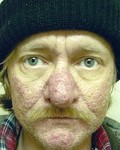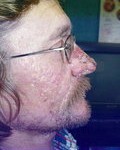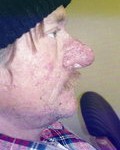![unnamed[1]](http://www.midwestsinus.com/wp-content/uploads/2015/05/unnamed11-150x150.jpg)
![unnamed[1]](http://www.midwestsinus.com/wp-content/uploads/2015/05/unnamed1-150x150.jpg) The term rhinophyma is derived from the Greek rhis (‘nose’) and phyma (‘growth’). Rhinophyma is a large, bulbous, ruddy nose caused by granulomatous infiltration, commonly due to untreated rosacea. It has often been referred to as “potatoe nose”. It is most common in white men with a mean age of 50.
The term rhinophyma is derived from the Greek rhis (‘nose’) and phyma (‘growth’). Rhinophyma is a large, bulbous, ruddy nose caused by granulomatous infiltration, commonly due to untreated rosacea. It has often been referred to as “potatoe nose”. It is most common in white men with a mean age of 50.
Signs and symptoms

 Rhinophyma is characterized by prominent pores and a fibrous thickening of the nose, sometimes with papules. It is caused by chronic overgrowth of the sebaceous glands and overgrowth of the colonizing bacteria Dermodex Folliculorum. It is associated with the common skin condition rosacea and can be thought of as the end stage of acne rosecea. It can carry a strong psychological impact due to its effect on one’s personal appearance.
Rhinophyma is characterized by prominent pores and a fibrous thickening of the nose, sometimes with papules. It is caused by chronic overgrowth of the sebaceous glands and overgrowth of the colonizing bacteria Dermodex Folliculorum. It is associated with the common skin condition rosacea and can be thought of as the end stage of acne rosecea. It can carry a strong psychological impact due to its effect on one’s personal appearance.
Causes

 Alcoholism is mistakenly attributed as a cause of this disease, but heavy alcohol consumption does aggravate the condition due its to chronic vasodilation effects. Rhinophyma may be diagnosed without testing, but a skin biopsy can confirm the diagnosis. Surgical treatment may be beneficial.
Alcoholism is mistakenly attributed as a cause of this disease, but heavy alcohol consumption does aggravate the condition due its to chronic vasodilation effects. Rhinophyma may be diagnosed without testing, but a skin biopsy can confirm the diagnosis. Surgical treatment may be beneficial.
Rhinophyma is a slowly progressive condition due to hypertrophy of the sebaceous glands of the tip of the nose often seen in cases of long-standing acne rosacea; it is not a neoplasm. It presents as a pink, lobulated mass over the nose with superficial vascular dilation; it mostly affects men past middle age. Patients seek advice because of the perceived unsightly appearance of the enlargement, or obstruction in breathing and vision.
Treatment
![640px-Domenico_ghirlandaio,_ritratto_di_nonno_con_nipote[1]](http://www.midwestsinus.com/wp-content/uploads/2015/05/640px-Domenico_ghirlandaio_ritratto_di_nonno_con_nipote1-150x150.jpg) Treating with topical Metrogel seems like a good idea in theory with its activity against Dermodex folliculorum, however, it really does very little in reality. Treatment consists of paring down the bulk of the tissue with a sharp instrument or carbon dioxide laser and allowing the area to re-epithelialise. Sometimes, the tissue is completely excised and the raw area skin-grafted. I personally have never tried putting a skin graft on this and many of my colleagues think this would be a bad idea. With the deep and ever present epithelial elements I would expect it to re epithelialize completely in less than a month with just conservative cares (H2O2 and bactroban applied TID). The painting on the right is from Domenico Ghirlandaio (1449 – 11 January 1494), he was an Italian Renaissance painter from Florence.
Treating with topical Metrogel seems like a good idea in theory with its activity against Dermodex folliculorum, however, it really does very little in reality. Treatment consists of paring down the bulk of the tissue with a sharp instrument or carbon dioxide laser and allowing the area to re-epithelialise. Sometimes, the tissue is completely excised and the raw area skin-grafted. I personally have never tried putting a skin graft on this and many of my colleagues think this would be a bad idea. With the deep and ever present epithelial elements I would expect it to re epithelialize completely in less than a month with just conservative cares (H2O2 and bactroban applied TID). The painting on the right is from Domenico Ghirlandaio (1449 – 11 January 1494), he was an Italian Renaissance painter from Florence.
Leave a Reply